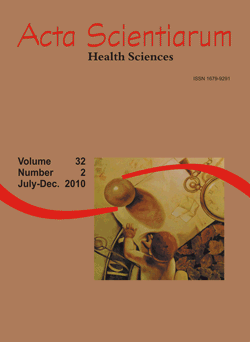<b>Electromyography of the temporalis and masseter muscles in children with right unilateral crossbite</b> - doi: 10.4025/actascihealthsci.v32i2.4952
Keywords:
Electromyography, malocclusion, mastication
Abstract
This study proposal was to evaluate the changes at a masticatory muscle temporalis and masseter, through a eletromyographic, at ponters of the right unilateral bite posterior, verifying the difference at the eletric activity between right and left sides. Twenty female volunteers, with ages between 7 and 8 (x = 7.4). The eletromyographics signals were collected in both sides in all volunteers in rest situations and in an usual isotonic mastication, right, left and bilateral and the maximun isometric constriction, which sinal was used to the eletric activity amplitude normalization. The results signed that the right masseter muscle presents an expressive statistic difference, if compared with the left masseter muscle during the left and right mastication, suggesting a right unilateral mastication. The muscle haven't gotten any expressive variance in this amplitude which remained to a proximate flat noticed in a right and habitual mastication, suggesting a right and one sided mastication during the left mastication occurs a raise of the eletric signal amplitude of the muscle left masseter. The right masseter muscle haven't gained any expressive variance, which remained in a proximate flat observed in an usual and right mastication, suggesting a muscular pattern hyperfunction next to the dental crossing.Downloads
Download data is not yet available.
Published
2010-09-28
How to Cite
Pissulin, C. N. A., Bérzin, F., Negrão Júnior, R. de F., Oliveira, A. S. B., & Pissulin, F. D. M. (2010). <b>Electromyography of the temporalis and masseter muscles in children with right unilateral crossbite</b> - doi: 10.4025/actascihealthsci.v32i2.4952. Acta Scientiarum. Health Sciences, 32(2), 199-204. https://doi.org/10.4025/actascihealthsci.v32i2.4952
Issue
Section
Dentistry Articles
DECLARATION OF ORIGINALITY AND COPYRIGHTS
I Declare that current article is original and has not been submitted for publication, in part or in whole, to any other national or international journal.
The copyrights belong exclusively to the authors. Published content is licensed under Creative Commons Attribution 4.0 (CC BY 4.0) guidelines, which allows sharing (copy and distribution of the material in any medium or format) and adaptation (remix, transform, and build upon the material) for any purpose, even commercially, under the terms of attribution.
Read this link for further information on how to use CC BY 4.0 properly.























5.png)







